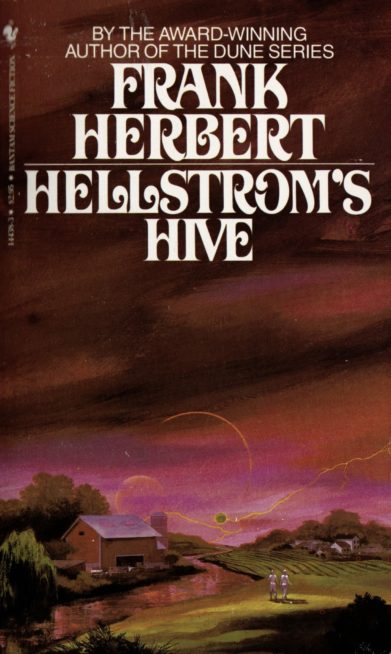By FRANK HERBERT (Bantam; 1973/82)
There are some good ideas in this, a post-DUNE Frank Herbert science fiction novel bearing a concept that evidently obsessed him: human-insect hybridization. It was an idea that Herbert previously explored in THE GREEN BRAIN (1966), and he’d do so again in GOD EMPEROR OF DUNE (1981). HELLSTROM’S HIVE, initially published in serialized form in 1972-73, is perhaps his most concise expression of that idea.
Its inspiration was the 1971 film THE HELLSTROM CHRONICLE, a quasi-documentary co-directed by the prolific screenwriter Walon Green (whose credits include THE WILD BUNCH and SORCERER) and scripted by David Seltzer (of THE OMEN). About a paranoid scientist named Nils Hellstrom (played by Lawrence Pressman), the film was comprised largely of then state-of-the-art insect photography dramatizing Hellstrom’s contention that bugs were primed to over-take the Earth.
the film was comprised largely of then state-of-the-art insect photography dramatizing Hellstrom’s contention that bugs were primed to over-take the Earth.
In HELLSTROM’S HIVE, Nils H., we learn, is a real guy residing in an Oregon compound known as the Farm. He apparently uses documentary films as a front for something called Project 40, which involves the creation of insectoid humans in a carefully ordered Hive located beneath the farm, with the project’s ultimate design being to replace humanity and take over the world. Sounds like fun, but this 312 page novel’s focus is on a group of uninteresting government operatives working for a secretive organization known as the Agency, which is mounting a raid on the Farm due to reports that Hellstrom is developing a weapon of mass destruction—which indeed he is.
There are a couple of enjoyable subplots to be found in this overly single-minded narrative. One of them involves a higher-up in the Agency getting seduced by Fancy, a Hive bred seductress who injects him with a hormone that causes eighteen back-to-back orgasms, followed by a heart attack (“Bluntly, he fucked himself to death”). Another involves an Agency wonk named Janvert being inducted into the Hive, and suffering a schizoid split as a result.
“Bluntly, he fucked himself to death”
For the most part, though, the proceedings are quite repetitive. We get endless passages about Agency orderlies tightening their surveillance around the Farm and Hellstrom hand-wringing over the possibility that his sanctum is about to be invaded, interspaced with dull philosophical asides about insects and their relationship with humankind.
It takes until the last forty pages for us to get a full description of the interior of the Hive, courtesy of an elevator descent by Janvert, and it’s a bit of a disappointment. It’s also less than plausible that Hellstrom, having painstakingly designed and orchestrated this cloistered universe, allows it be so easily breached. I have no problem with thoughtful sci fi speculation in a B-movie framework, which HELLSTROM’S HIVE very much is, but it needs to be pulled off with a bit more flair than it was here.

